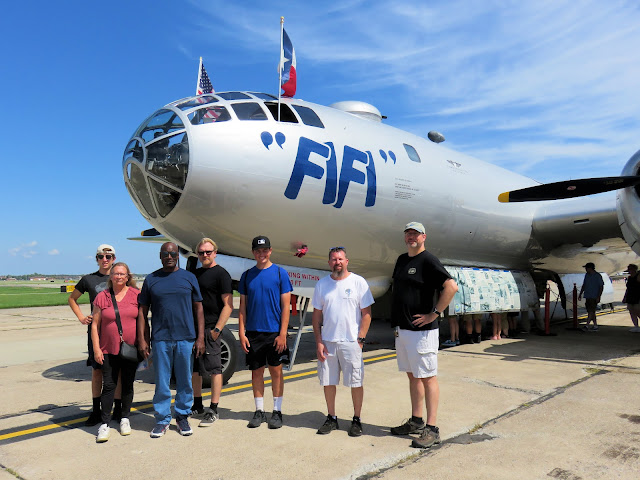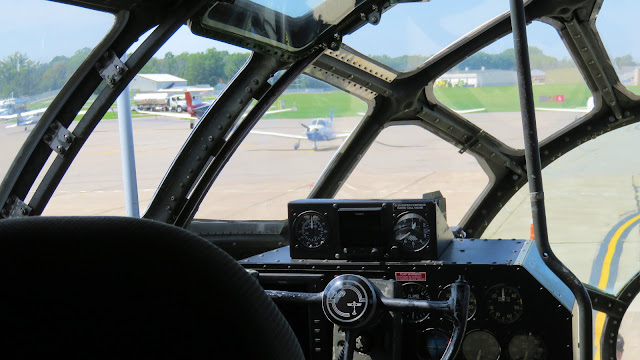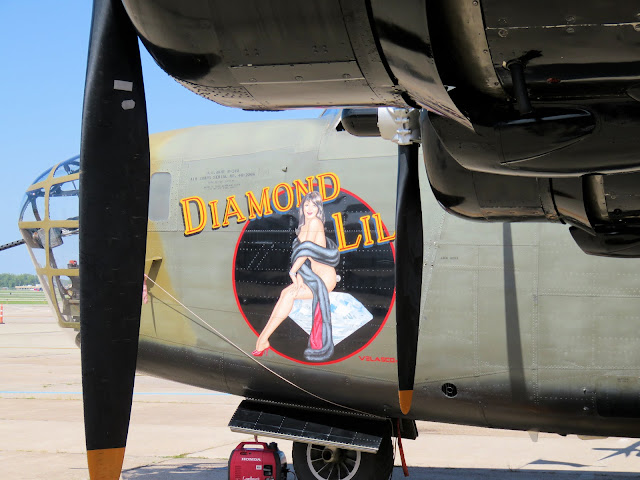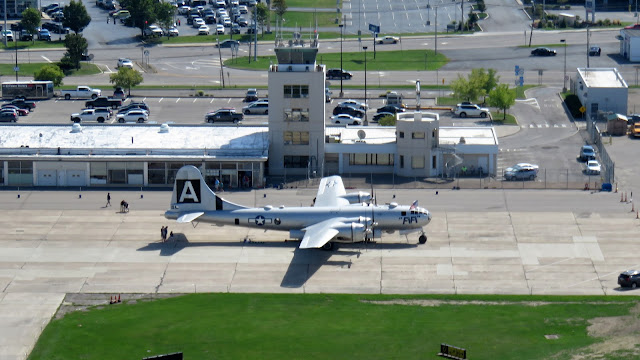Keep 'em Flying!
 |
| The WFC with Fifi. Photo by Kim. |
"Keep 'em flying."
The AirPower Squadron of the Commemorative Air Force (CAF) excels at turning this mantra into practical reality. Each summer, their vintage aircraft zoom to all corners of the country, introducing new generations to the magnificent flying machines of World War II. The 2022 tour included Fifi, one of two B-29 Superfortresses still flying; Diamond Lil, one of only two B-24 Liberator heavy bombers still flying; Gunfighter, a two seat P-51 Mustang fighter; and a Stearman biplane.
Because of their rarity, I have been looking forward to an opportunity to see the B-24 and B-29 in action. On September 3, 2022 members of the Williamson Flying Club flew to Niagara Falls International Airport (KIAG) to do exactly that.
Previous Date with Diamond Lil and Fifi
My first and only other encounter with Diamond Lil and Fifi occurred July 2004 in Kalamazoo, MI when the Commemorative Air Force spent some time at the Air Zoo. At the time, Fifi was the only B-29 still flying in the world.
 |
| Taken from Dave's Super Decathlon on 25 July 2004. |
 |
| B-24 Liberator Diamond Lil on the Air Zoo ramp. 22 July 2004. |
 |
| Diamond Lil at the Air Zoo, 22 July 2004. |
 |
| Diamond Lil's port outboard engine, 22 July 2004. |
 |
| Inside the cockpit of Diamond Lil, 22 July 2004. |
We had excellent access to the B-24 bomber (except, obviously, for touching things), but there was no opportunity to climb inside the magnificent B-29.
 |
| Fifi cockpit photo taken 22 July 2004. |
This was extremely disappointing to me because the B-29 was the first airplane that captured my attention at a kid. This is most likely because the cockpit was an obvious inspiration for the Millennium Falcon. Fortunately, a set of stairs was pushed up to an open window at Fifi's flight engineer station and I was able to point a camera inside to capture a blind shot through the B-29's iconic cockpit windows.
Someday, I wanted to actually stand on that flight deck. I did not know it at the time, but eighteen years would pass before that happened.
B-29, Holding Short for Landing Cherokee
| Date | Aircraft | Route of Flight | Time (hrs) | Total (hrs) |
| 03 Sep 2022 | N21481 | SDC (Sodus, NY) - IAG (Niagara Falls, NY) - SDC | 2.2 | 2528.3 |
Scott, Kim, and I launched in Warrior 481 at 8:30 am Saturday morning. The flight to Niagara Falls lasted nearly an hour.
 |
| Boeing B-29 Superfortress Fifi holding short on runway 6 for Warrior 481 to land. |
Niagara Falls International was busier than usual when we arrived due to the various CAF airplanes flying that morning. We were instructed to keep our speed up on final, land on runway 28R, do a 180° turn on the runway and taxi back to the approach end, then follow taxiway Delta to the Calspan ramp on the south side of the field.
The reason for this unusual set of instructions was that Fifi was holding short of runway 28R on runway 6 waiting for us to land and clear the runway. It is not every day that such a historically-important aircraft has to wait on me! Equipped with four, eighteen cylinder radial engines possessing a combined total displacement of about 13,400 cubic inches, I bet Fifi idled away a lot more fuel than I would have had our roles been reversed.
Rides in Fifi cost between $600 for poor visibility gunner compartment seats near the tail to $1700 for the highly desirable bombardier's seat right up front. Fuel and maintenance costs are likely substantial; there is a reason why these rides cost so much.
 |
| Kim and Scott with Warrior 481 on the Calspan ramp. |
At Calspan, we waited for the other participating members to arrive. Lesly was next in his beast of a turbo Saratoga. Flying with Lesly were the club's chief flight instructor (Mike B) and three other members. Lesly's arrival was further delayed when Tower issued delay vectors so Fifi could land first. Mike A, our event organizer, was last to arrive in Eight Five X-Ray with his family on board.
 |
| Mike A in 85X arrives on the Calspan ramp. That Warrior looks familiar. |
Reconnection with Fifi
Obviously, the B-29 has deep historical significance. It was the long range heavy bomber pressed into service for nuclear weapon delivery at the end of World War II, the only aircraft with the capability to carry the atomic bomb and the endurance to make the flight from Tinian to Japan with enough fuel to reach a safe harbor.
What we witnessed in Niagara Falls is that B-29 take-offs are quite shallow. This is done in an attempt to maintain an adequate flow of cooling air over the massive Wright R-3350 radial engines.
The massive B-29 is a sight to behold from the ground.
I envy the lucky soul sitting in that $1700 prestige seat, the man I have nicknamed "Socks". My friend Joe got the ride of a lifetime in that very seat in 2015. What a view that must be!
 |
| Fifi taxies in after landing. |
Fifi and Warrior 481, the aircraft that first sparked my fascination with airplanes together with the one that sustains it.
Even though we were parked adjacent to the apron where the CAF planes were, we needed to exit through the street side Calspan entrance and walk slightly down the street to re-enter at the Niagara Falls Aerospace Museum. On the way, we passed the Niagara Falls Tower entrance that boasts a massive mail box! Is that to manage large bundles of fan mail?
Up close and personal with Fifi for the first time in eighteen years, the B-29 is no less impressive now than it was then. One of the things that amazes me about the B-29 is its illusion of simplicity. At the time, it was one of the most technologically advanced aircraft ever produced, yet at first glance it falsely appears to be a simpler aircraft than the B-17 Flying Fortress that preceded it.
 |
| Warrior 481 framed by two of Fifi's propellers. |
 |
| Gunnery observation window. |
We entered the bomber through the forward bomb bay then climbed a ladder to the flight deck.
Meant for high altitude flight (up to 31,850 feet), the B-29 was the first pressurized heavy bomber. To avoid issues of depressurization when opening the bomb bays, only the front and rear compartments are pressurized. They are connected by a long, pressurized tunnel running along the top of the bomb bays as photographed above.
At the rear of the flight deck, a convex bulkhead marked the entrance to the pressurized section of the aircraft.
Peering down the long tunnel connecting the forward and aft pressurized compartments of the B-29, I suspected that it was a great way for those Army Air Corps guys to practice their Army crawls.
After eighteen years, I was finally standing on the flight deck of a B-29 and peering out through that iconic, multipaned window. I noticed some upgrades since my last peek into the cockpit, specifically a pair of G5 instruments (like in Warrior 481) replacing gyroscopic attitude indicators at the pilot and copilot positions.
Standing on Fifi's flight deck was a more authentic Millennium Falcon experience than riding Smuggler's Run at Disney.
This is what the B-29 pilot would see if Warrior 481 were strafing it with her nonexistent guns. Nerdiest photograph ever, but it was a shot I just had to take.
The engineer's station represents the greatest level of complexity on the flight deck. No new glass instruments here.
After a brief cockpit tour, we climbed down a ladder behind the pilot and copilot seats to emerge from the wheel well aft of the nose gear.
 |
| Group photo: Phil, Jean, Lesly, Mike B, a member whose name I do not know, Scott, and me. Photo by Kim. |
It was a brief tour, but very satisfying. I am so glad that I participated in this event!
Smaller Scale Wonders
I do not mean to impugn the Stearman. It is a wonderful biplane and responsible for teaching so many American World War II aviators how to fly. But they are common enough that even I have stick time in one (Dave's). The rare novelty of an airworthy B-29 shone too brightly for me to take much notice of an otherwise very important aircraft.
The P-51 Mustang was a fine specimen and one that I have not encountered before. Equipped with a back seat, 20 minute rides were available for $2300. This seemed a little steep, but it was nonetheless hard not to be jealous of passengers as the Mustang broke ground in Niagara Falls and banked steeply overhead.
 |
| Niagara Falls Tower |
Diamond Lil Got a Makeover!
 |
| B-24 Liberator Diamond Lil above Niagara Falls. |
During World War II, the primary heavy bombers used by the US Army Air Corps were the B-17 Flying Fortress (like the Memphis Belle) and the B-24 Liberator. Personally, I am more enamored with the B-17 than the slab-sided Liberator, but I think this is an aesthetic bias.
 |
| B-24 Liberator Diamond Lil above Niagara Falls. |
B-24s were produced in greater numbers than B-17s during the war. This includes contributions from Ford whose Willow Run, MI plant was able to produce one Liberator every 63 minutes from a massive manufacturing plant that was over one mile long. Liberators were generally faster though B-17s could fly higher. The B-17 was reputedly easier to fly, had a lower stall speed, and was easier to ditch successfully.
Diamond Lil obviously received a new paint job since 2004. Starting in 2006, the airplane was dressed as Ol' 927 but redubbed Diamond Lil in 2012. Damage following a hydraulic failure in 2012 led to a restoration of the B-24 that was completed in 2013.
It is my opinion that the new paint job is of higher quality than what I saw in 2004.
When it was our turn to explore the bomber, Kim immediately looked for a way to work off some aggression.
 |
| Peering down the empennage toward the tail gunner position. |
We had to stoop low to work our way forward toward the cockpit. The overhead bulkhead seeming to sag over the walkway is a fuel tank.
Comparison of these pictures to the ones I took in Kalamazoo shows that the instrument panel received some updates over the years. I imagine that that GNS-530 navigator would have been a significant tactical advantage in World War II. (Well, aside from lacking a satellite constellation to reference.)
In 2022, even vintage World War II aircraft take advantage of an iPad's capabilities for charting.
Niagara Falls Aerospace Museum
We spent a bit of time in the Niagara Falls Aerospace Museum, which had a few interesting artifacts. But we lacked the attention span to really explore the place. We were hot and tired after hours in the sun. Lunch was minimal. Despite a promise of food trucks at the event, none of them showed up that day. Scott, Kim, and I did not get a real lunch until 4:00 when we visited Orbaker's just down the street from the Williamson Sodus Airport.
This was a particularly interesting display at the museum. I may have been a little dehydrated and sun addled, but I was pretty sure that this astronaut looked just like the A-10 pilot we saw in Long Island's Cradle of Aviation Museum!
One of the most eye-catching exhibits was a Niagara Falls-built Bell P-39 Airacobra Miss Lend Lease, one of 9,600 P-39s loaned to the Soviet Union during World War II. She was recovered from Lake Mart-Yavr within the Arctic Circle in 2004 where Lieutenant Ivan Baranovsky ditched her after a 1944 engine failure.
Lesly and crew in the Saratoga preparing to depart Niagara Falls for Sodus.
Shortly after breaking ground, I captured one final photo of my object of obsession before turning on course for home.
What a cool day!













































No comments:
Post a Comment